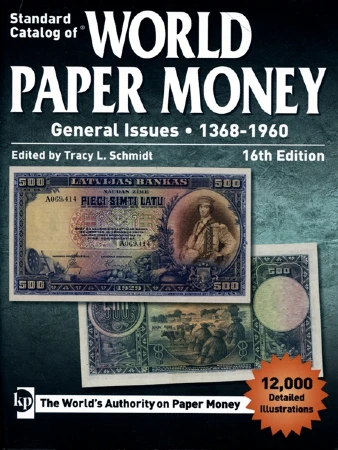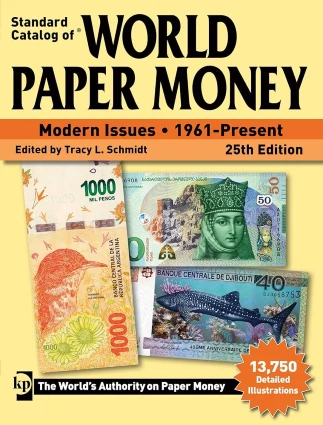In ColeMone, quite often, we dedicate an article to explaining basic concepts in a sort of numismatic glossary. Today we are looking at one of those basic things that, if you’re going to get into banknote collecting, you need to know for sure: what is, where to find, and who decides the Pick number (or code) of a banknote.
The Pick Number of a banknote is a number belonging to the classification system established in the various volumes of the Standard Catalog of World Paper Money, also called “Pick Catalogs,” and they are indicated with a “P.” Each type of banknote has its number, and the numbers for each country start with P#1.
The Standard Catalog of World Paper Money
The Standard Catalog of World Paper Money is the quintessential catalog of banknotes worldwide and serves as the global standard for classification, usually accompanied by another catalog at the country level. The first edition was published in 1975 and was the work of the German numismatist and banknote collector Albert Pick. Hence it is called the Pick number.
It is basically the banknote equivalent of the KM Number for coins.
In its latest editions, the Standard Catalog of World Paper Money has been divided into three different volumes.
The first is dedicated to banknotes from 1368 to 1960. The latest edition, number 16, was published in 2016.

The second volume covers from 1961 to the present. The latest edition, number 25, was published in 2019.

And the third volume focuses on specialized issues, such as local banknotes or issues for collectors. Its latest edition, number 12, dates back to 2012.

Unfortunately, there may not be any more editions.
The company that published them, F+W, filed for bankruptcy in 2020, and its assets were auctioned off and bought by many other companies. The book publishing business was acquired by the giant Penguin Random House, and the numismatic and notaphilic magazine publishing business was acquired by the American publisher Active Interest Media, which would eventually also purchase Krause Publications from Penguin, thus taking over F+W’s entire numismatic segment.
Since then, there has not been a physical edition of the Standard Catalog. But that does not mean that the KM Code is dead.
Active Interest has maintained the spirit of the Pick Code on its Numismaster website, which has a catalog of world banknotes. There, it’s called the SC Number (indicated as SC#), presumably for reasons of intellectual property rights. The process of assigning the SC is the same as that of the Pick.
Let’s look at that process.
How is the Pick number of a banknote assigned?
The specific algorithm by which a Pick number is assigned to a banknote is proprietary and, therefore, theoretically secret.
However, after many years of using these catalogs for classification, collectors have been able to identify certain patterns that have repeated over time.

The Pick number is unique for each country. That is, there is a P#1 for Spain, another for China, another for Ghana… And within each country, banknotes are ordered by year of issue, first from oldest to newest, and then from lowest to highest denomination.
Prefixes
Sometimes, the Pick number has a prefix, like P#FX345. It always appears in uppercase, and the following ones may appear:
- “A” and “B” prefixes (e.g., P#A123 and P#B123): For banknotes that were skipped in the original numbering and had to be added later. To avoid renumbering an entire country, these prefixes are introduced.
- “CS” prefix (e.g., P#CS123): For collector’s editions.
- “FX” prefix (e.g., P#FX123): For foreign currency conversion certificates.
- “M” prefix (e.g., P#M123): For banknotes belonging to military issues.
- “R” and “S” prefixes (e.g., P#R123 and P#S123): For specialized issues, such as local banknotes, private bank issues, notgeld, etc.
Suffixes
The Pick number can also have a suffix at the end, like P#123tc. Unlike prefixes, suffixes are in lowercase. The following suffixes may appear:
- “a“, “b“, “c”, etc. suffixes (e.g., P#123a, P#123b, P#123c…): For each issue date of the same banknote.
- “ct” and “tc” suffixes (e.g., P#123ct and P#123tc): For color trials.
- “r” suffix (e.g., P#123r): For replacement banknotes and printed but unissued banknotes.
- “p” suffix (e.g., P#123p): For proofs.
- “s” suffix (e.g., P#123s): For specimens.
- “x” suffix (e.g., P#123x): For counterfeits and errors.
Sometimes, a number may appear after the suffix. This means there are several versions of whatever the suffix indicates. For example, if we encounter the banknote P#345tc1, it would mean it is the first of several color trials of the banknote with Pick 345.
How to read the Standard Catalog of World Paper Money?
Once you know what the codes mean, reading and interpreting the Standard Catalog of World Paper Money correctly is not too difficult.

Each banknote has its entry, and typically it includes a photo of the banknote (although not always), and below, its Pick number, denomination, description, and its values in dollars and in the Very Fine and Uncirculated grades of the traditional American grading scale.
Be cautious with the values
When reading the catalog, it’s important to be cautious with the values. It’s been quite some time since the last edition of each volume of the Standard Catalog of World Paper Money, and as of today, they may be quite outdated.
Even if the ones in Numismaster, which are supposed to be up-to-date, tend to reflect the state of the American collector market, which almost certainly will be vastly different from the market or the country you are reading this from (unless you’re reading from the US, of course).
It’s best not to take those figures literally. Rather, take them as an indication of which banknote is valuable and which one is not as much.
So, if you’re going to start collecting banknotes, that’s all you need to know about the Pick number. Let’s hope we have a new physical edition of the catalogs sooner rather than later.